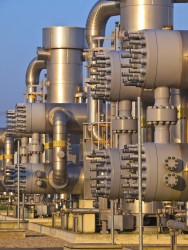Using Metal Hose in Chemical Plants
By: Andrew Veri | On: August 4, 2016

Using metal hose in chemical plants is ideal. Metal hose is used in a wide variety of applications in some of the harshest industrial environments. Stainless steel hose can handle temperature and pressure extremes, and is not susceptible to permeation of the media. In addition, stainless steel corrugated hose has the ability to handle a wider variety of chemicals than most other hose types. For all of these reasons, metal hoses are widely used in all types of chemical plants.
One of the main applications for metal hose in chemical plants is at chemical blending stations. When designing these blending stations, every aspect of the hose must be taken into account. This includes the plumbing, the piping, and the orientation of the header. Avoiding tight bends in the hose, a very common issue at chemical plants, is a key when planning the piping system.
Another often overlooked attribute of a metal hose in a chemical plant is that many applications require an operator to handle the hose on a regular basis. Since these hoses are handled so frequently, choosing the correct hose and assembly configuration are essential. Metal hose has the ability to handle the nasty chemicals while still maintaining a weight light enough for the workers to move the hose with ease. It also offers a very long working live length compared to non-metallic assemblies, which further facilitates handling by the operators.
Metal hose is easily customized without the need for adapters. Stainless steel fabrication techniques provide the ability to use a wide array of fitting configurations. The need to easily connect and disconnect hoses quickly and often makes cam and groove couplings a popular and smart choice for chemical plants. When moving hoses from one outlet to another, users can sometimes over-bend the hose near the end fitting while trying to get the proper connection, causing it to fail prematurely. To solve this issue, a bend-restrictor can be put on the hose. This short piece of stripwound armor makes sure that the flex of the hose is not concentrated near the end fitting.
While the internal makeup of the hose is important, at chemical plants the outer layer of a metal hose can be equally important. These hoses are subjected to the weather and the environment of the plant. Hoses that are moved often might be dragged or rubbed along concrete or metal including grates and other equipment. To protect the stainless steel braid (the component that gives the hose its pressure holding capability), a spring guard or stripwound stainless steel armor may be put over the hose to protect the braid wires from wearing away or breaking.
In cold weather climates, chemical plants conveying viscous media may need to use a traced or jacketed hose assembly to keep the media flowing. In these configurations, a two hose system is used. One of the hoses is carrying steam (or hot oil), while the other hose carries the media being conveyed. The steam keeps the viscous media warm, allowing it to continue to flow, even in frigid temperatures. By keeping the media flowing smoothly, the plant can avoid problems such as a costly shutdown.
There are many factors that can contribute to handling issues with metal hose in chemical plants. Between the media being conveyed, the area of the plant in which hose is being used, and who is using the hose, there are many ways handling issues can arise. Not to mention, the climate of the geographical area the plant is in can play a part. With proper hose preparation and selection, many of the issues that the plant may face can be minimized or avoided.
Contact or call (800-221-2319) our Inside Sales team for assistance in hose selection and design.
Copyright 2016, Hose Master, LLC
All Rights Reserved

